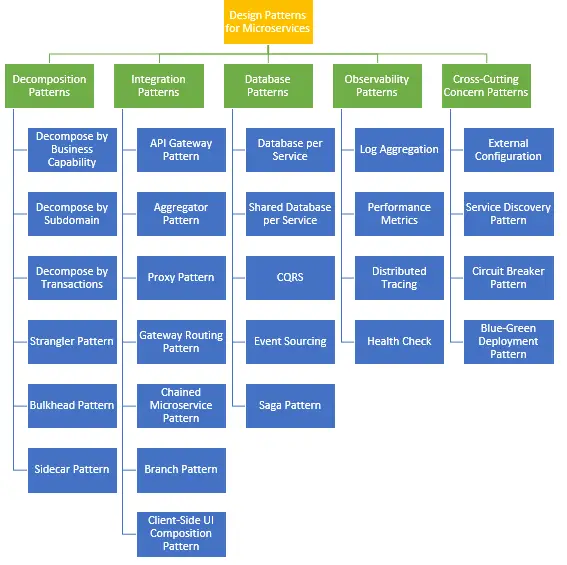Microservices Architecture Styles

1. API-Driven Architecture
In this style, each service exposes well-defined APIs (e.g., REST, GraphQL, gRPC) to communicate with other services or consumers.
- Example: Services like
UserService,OrderService, andPaymentServiceinteract using RESTful APIs.
Advantages:
- Clear communication interfaces.
- Easy to document with tools like Swagger or OpenAPI.
Challenges:
- Network overhead due to multiple API calls.
- Hard to ensure backward compatibility when APIs change.
2. Event-Driven Architecture
This architecture focuses on services communicating asynchronously by exchanging events through a message broker (e.g., Kafka, RabbitMQ).
- Example: When an
OrderServicecompletes an order, it emits anOrderPlacedevent, triggering theInventoryServiceto update stock.
Advantages:
- Decouples services, improving scalability and resilience.
- Handles spikes in demand gracefully with message queues.
Challenges:
- Hard to guarantee data consistency.
- Complex to track end-to-end workflows.
3. Service Mesh Architecture
A service mesh provides a dedicated infrastructure layer to handle communication between microservices, abstracting networking concerns (e.g., retries, load balancing, encryption).
- Example: Tools like Istio or Linkerd manage communication between services, applying policies like rate limiting and retries.
Advantages:
- Centralized management of cross-cutting concerns (e.g., security, monitoring).
- Easier to enforce policies like authentication and observability.
Challenges:
- Adds operational complexity.
- Requires deep understanding of networking concepts.
4. Saga Pattern (Distributed Transactions)
This pattern is used to manage distributed transactions across microservices by breaking them into smaller, independent steps with compensating actions for rollback.
- Example: An order placement triggers multiple services—
OrderServicecreates the order,PaymentServiceprocesses the payment, andInventoryServicereduces stock. If payment fails, each service rolls back.
Advantages:
- Handles long-running distributed transactions without locking.
- Ensures eventual consistency across services.
Challenges:
- Complex to implement and debug.
- Requires careful design of compensating transactions.
5. CQRS (Command Query Responsibility Segregation)
This architecture separates write operations (commands) from read operations (queries) to improve performance and scalability.
- Example:
OrderServicestores orders in a write-optimized store (e.g., SQL) and updates a read-optimized store (e.g., Elasticsearch) for fast querying.
Advantages:
- Optimized for both reads and writes.
- Reduces contention on the database.
Challenges:
- Requires synchronization between write and read models.
- More complex to maintain and implement.
6. Serverless Microservices
In serverless architectures, services are broken into function-as-a-service (FaaS) components that run only when triggered, reducing infrastructure management.
- Example: AWS Lambda functions handle user registration and order processing on demand.
Advantages:
- No need to manage infrastructure.
- Scales automatically with demand.
Challenges:
- Cold-start latency can affect performance.
- Harder to manage state between function calls.
7. Sidecar Pattern
The sidecar pattern involves running auxiliary components (e.g., logging, monitoring) alongside the main service in the same pod/container.
- Example: A sidecar container running Prometheus for monitoring or Envoy for service discovery.
Advantages:
- Decouples cross-cutting concerns from core logic.
- Improves observability and maintainability.
Challenges:
- Increases operational overhead (more containers to manage).
- Requires careful synchronization between the main service and sidecar.
8. Domain-Driven Design (DDD) Architecture
Microservices are modeled around business domains or bounded contexts, each responsible for a specific part of the business.
- Example: A retail platform with services like
InventoryService,CustomerService, andOrderService, each aligned with business capabilities.
Advantages:
- Services reflect real-world business processes, improving clarity.
- Easier to assign ownership to specific teams.
Challenges:
- Requires deep understanding of business domains.
- Coordination between teams becomes crucial.
9. API Gateway Architecture
In this style, an API Gateway acts as a central entry point to route requests to multiple backend services, aggregate responses, and handle cross-cutting concerns (e.g., authentication, rate limiting).
- Example: A frontend request to place an order hits the API Gateway, which routes it to
OrderServiceandPaymentService.
Advantages:
- Simplifies client interactions with multiple services.
- Central place to enforce security policies.
Challenges:
- Gateway becomes a single point of failure.
- Can introduce latency if not properly configured.
10. Containerized Microservices Architecture
In this approach, each microservice runs in its own container (e.g., using Docker), ensuring isolation and portability across environments.
- Example: Microservices packaged in Docker containers and orchestrated using Kubernetes.
Advantages:
- Consistent and reproducible deployments across environments.
- Easy to scale individual services.
Challenges:
- Requires expertise in container orchestration (e.g., Kubernetes).
- Managing many containers can become challenging.
Conclusion
Each microservices architecture style offers unique benefits and challenges, and the choice depends on factors like scalability, consistency requirements, and the nature of the business domain. A hybrid approach—combining API-driven communication with event-driven patterns or using a service mesh with containerization—can often yield the best results for complex systems.


What you’re creating here is a true oasis of knowledge and inspiration! Every sentence is like a precious pearl, and together they form a fascinating necklace of wisdom. The only thing I found missing was slightly more detailed examples – that would have made it absolutely perfect!
Wow, thank you so much for the kind words! I’m really glad you found the content valuable. I appreciate the feedback about examples—I’ll definitely keep that in mind for future posts. Detailed examples can really bring concepts to life, so I’ll aim to incorporate more of them going forward. Thanks again for your support!